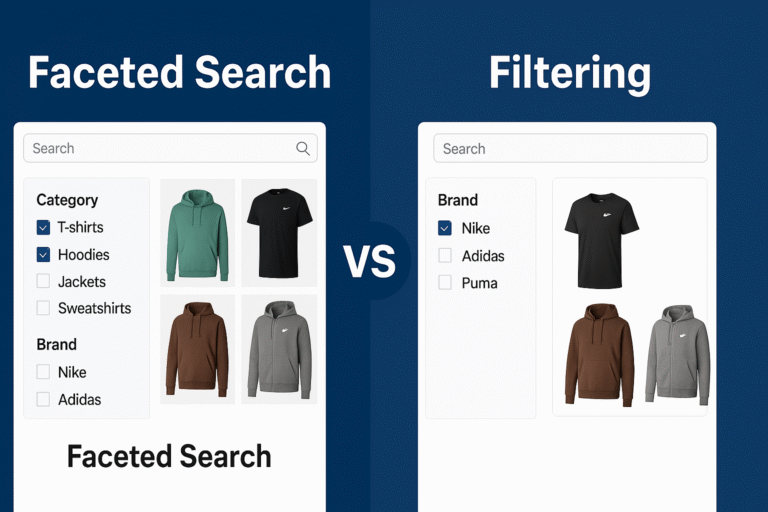You might believe that factors such as product selection and order fulfillment speed determine an eCommerce site’s overall success or failure. However, while these factors are significant, they pale in comparison to the fundamental backbone of the user’s shopping experience: eCommerce search.
And while it’s pretty straightforward to set up an eCommerce search engine, the real test is in how well it operates. The present article will walk you through the e-commerce product search, its functionalities, why is it important, and best practices of e-commerce product search for your better understanding of e-commerce search.
What is an e-commerce product search, and how does it work?
Visitors to your e-commerce site can use search engines to query your database and find answers to their questions about your organization and products or services.
The better your site search engine is configured, the easier it is for visitors to get the information they’re looking for on their own – without having to contact customer support or leave your website. The greatest e-commerce search engine is one that acts as a salesperson, answering questions, making suggestions, and guiding customers down the path to a joyful purchase.
Your e-commerce search engine, on the other hand, works around the clock and never begs for a raise. It does, however, necessitate your attention, particularly when it comes to testing and modifying to ensure that it meets your consumers’ specific needs.
Based on the usability of e-commerce site search, shoppers generally fall into one of four search categories:
Specific search: when a person knows exactly what they’re looking for, down to the product’s exact name (for example, “iPhone 7”).
Product type search: When a user looks for a broad product rather than a specific brand or model (for example, “laptop”), they are using product type search.
Problem-based search: when a person is looking for a solution to a problem but isn’t sure what kind of product they require (for example, “acne remedy”).
Non-product search: when a user seeks information rather than a product (for example, “opening hours” or “shipping choices”).
Successful site search tools make it simple for customers to conduct any of these types of searches, whether they know exactly what they want to buy or need more information before making a purchase.
Why is e-commerce search important?
Ecommerce search is essential because 1/3 of all online store visitors use the site search function, according to research.
Remember that visitors who come to your site via search have a clear objective – they have a conversion chance up to 6 times higher.
According to internal SearchNode data, searchers account for 30-60% of all eCommerce site earnings!
You can now monitor how much your overall revenue comes from search users. Typically, internet retailers who are unaware of these figures are taken aback. Although each firm is unique, the following are the most common trends in eCommerce search statistics:
Site search accounts for roughly 30% of all site sessions.
Sessions using site search have a 6x greater conversion rate.
Sessions with the search account for 30 percent to 60 percent of all site transactions.
Site search analytics may reveal what your consumers desire, how they talk about what they’re looking for, and which searches yield irrelevant — or no — results. For example, if you discover that many clients are looking for something you don’t have, you might want to consider expanding your product line.
On-site search is an important part of the customer journey for customers who either know exactly what they want and have come to your site to discover it or have a general concept of what they want but need some help narrowing it down.
The search experience is an essential component of the overall purchasing experience for your customers, and it may be a make-or-break moment for them.
Ecommerce product search best practices
Ecommerce search engines aren’t just decorative additions to your website. It must perform in the way that your customers expect it to, or else the customer journey will be harmed. Here are some recommended practices for establishing a properly optimized site search that smoothly guides high-intent shoppers through the sales funnel.
Allows for mistakes and typos:
Make sure your site’s search engine is set up to recognize phonetic misspellings and typos so that simple errors don’t result in a blank page. Natural language processing can improve search results by understanding a query’s intended meaning and assisting in the parsing of long, complex inquiries.

Synonymous results are provided:
Using synonyms in your search engine will assist consumers in locating the things they’re looking for. In some search solutions, you’ll have to manually add synonym libraries according to your requirements; in others, these libraries are built automatically using natural language processing (NLP).
Activate the search box:
Make sure people see your search box, which should go without saying. Around search bars, there are several usability-related best practices. Above all, this isn’t the place to let your imagination go wild. Place it where people expect to find it, and make it extremely clear to users what it is and how to use it — for example, by incorporating a visual icon of a magnifying glass, which is commonly recognized to mean search.
Don’t let your site search go blank:
If you have a high-intent shopper on your site, you don’t want to send them the message that you don’t have anything for them. That’s why it’s critical to ensure that typical queries get some results. Set up your solution so that it can recommend related products instead of providing an empty screen if you don’t have any relevant products to return.

Use data to help you fine-tune future site search settings:
Your search solution’s statistics may provide you with a plethora of information about your customers’ desires and how they think and shop. You’ll be able to observe if client vocabulary matches what’s on your product pages if you have enough data to make conclusions, and if it doesn’t, you’ll be able to take measures to connect the dots.
Set up the search functions for mobile devices:
The share of e-commerce traffic generated by mobile devices continues to rise. Various payment options continue to make the entire purchase process, from start to finish, more accessible to complete on a mobile device. As a result, it’s critical to ensure that your site’s search fully functions on mobile devices. Smart autocomplete suggestions, also known as query suggestions, can help mobile searchers stay on the move by decreasing the amount of input they have to do.
Add graphics and buttons to your search results:
The central truth is that your search results pages are a gold mine of information. A user with high intent has arrived because they are looking for something specific. You can do the following things by marketing your search results (also known as “searchandising” ):
To better manage what results are presented and when weighing your products differently.
If you don’t have the exact item your user is looking for, make relevant product recommendations.
Machine learning can be used to provide customized outcomes:
A search system with powerful machine learning capabilities can offer highly tailored results to gather information on items and individual shopper behavior, analyze product and attribute relationships, and find complicated patterns.
Frequently Asked Questions
Q1. In the world of eCommerce, what is smart search?
A1. By replying to consumers’ requests in the shortest time possible, a smart search tool can help your company create a strong relationship with customers. Furthermore, it will provide auto-suggest relevant products to your consumers, attracting first-time shoppers and encouraging them to return for more.
Q2. What is the meaning of product search?
A2. Customers can use search to identify specific products that meet a set of criteria. Simple and complex searching are the two sorts of searches available. A consumer can use simple searches to look for keywords
in the catalog. In an advanced search, a customer can use extra product attributes such as manufacturer, weight range, or part number.
Q3. Why is product search important?
A3. Product search is essential because consumers cannot physically see or touch the products; they require precise and complete information that helps them swiftly and easily locate a product, comprehend its features, and determine whether it is what they want or need. This helps in better judgment on the consumer’s part and enhances user experience resulting in the rise in sales.




